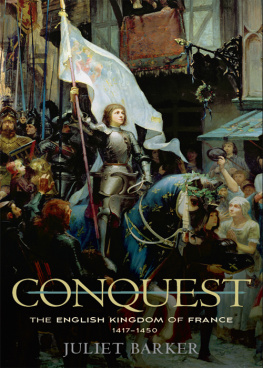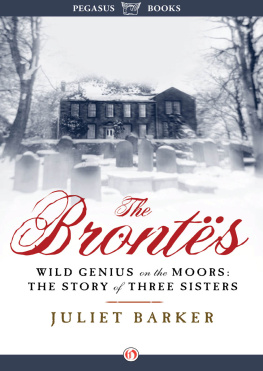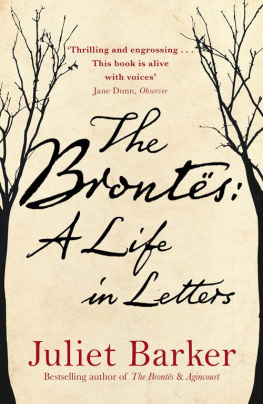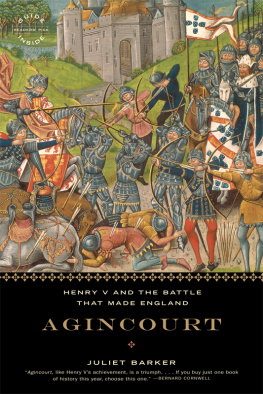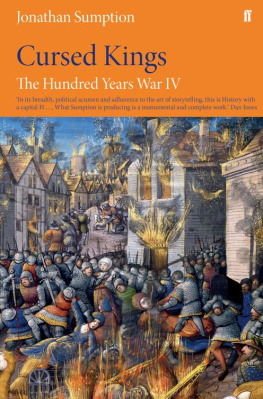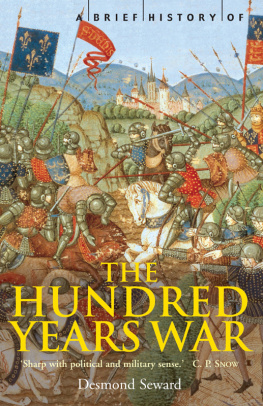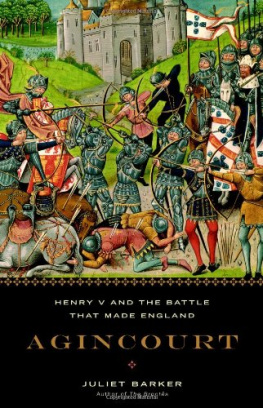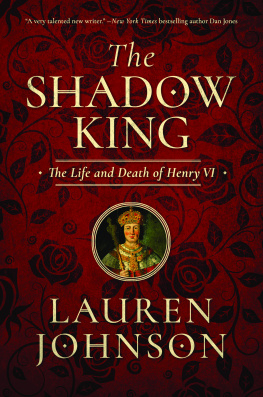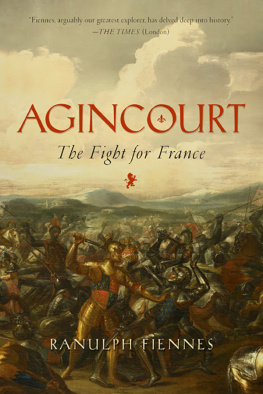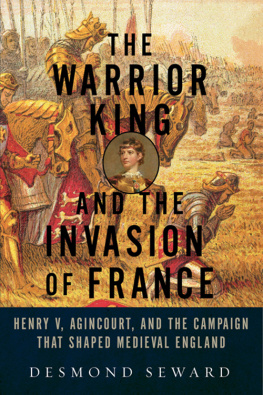CONQUEST
CONQUEST
The English Kingdom of France
14171450
JULIET BARKER
HARVARD UNIVERSITY PRESS
Cambridge, Massachusetts
2012
Copyright Juliet Barker 2009
Maps and family trees drawn by John Gilkes
All rights reserved.
First published in the United Kingdom in 2009 by Little, Brown Book Group
Typeset in Sabon by M Rules
Jacket image: Bridgeman Art Library International
Jacket design: Lisa Roberts
Library of Congress Cataloging-in-Publication Data
Barker, Juliet R. V.
Conquest : the English kingdom of France, 14171450 / Juliet Barker. 1st North American ed.
p. cm.
Originally published: London : Little, Brown, 2009.
Includes bibliographical references and index.
ISBN 978-0-674-06560-4 (alk. paper)
1. Charles VII, King of France, 14031461. 2. FranceHistory Charles VII, 14221461. 3. Joan, of Arc, Saint, 14121431. I. Title. II. Title: English kingdom of France, 14171450.
DC102.B275 2012
944.026dc23 2011042096
This book is dedicated to Judith Bateson who died on 23 May 2009. She was not just my beloved mother but my man on the Clapham omnibus for every book I have written. I am bereft without her.
CONTENTS
The Hundred Years War is defined in the popular imagination by its great battles. The roll-call of spectacular English victories over the French is a source of literary celebration and national pride and even those who know little or nothing about the period or context can usually recall the name of at least one of the most famous trilogy Crcy, Poitiers, Agincourt. It is curious therefore that an even greater achievement has been virtually wiped from folk memory. Few people today know that for more than thirty years there was an English kingdom of France. Quite distinct from English Gascony, which had belonged to the kings of England by right of inheritance since the marriage of Eleanor of Aquitaine and Henry II in 1152, the English kingdom was acquired by conquest and was the creation of Henry V.
When he landed a great English army on the beaches of Normandy at the beginning of August 1417 Henry opened up an entirely new phase in the Hundred Years War. Never before had an English monarch invaded France with such ambitious plans: nothing less than the wholesale conquest and permanent annexation of Normandy. Yet, after he had achieved this in the space of just two years, the opportunity presented itself to secure a prize to which even his most illustrious ancestor, Edward III, could only aspire: the crown of France itself. On 21 May 1420 Charles VI of France formally betrothed Henry V of England to his daughter and recognised him as his heir and regent of France. In doing so he disinherited his own son and committed both countries to decades of warfare.
By a cruel twist of fate, Henry died just seven weeks before his father-in-law, so it was not the victor of Agincourt but his nine-month-old son, another and much lesser Henry, who became the first (and last) English king of France. Until he came of age and could rule in person, the task of defending his French realm fell to his fathers right-hand men. First and foremost among these was his brother John, duke of Bedford, a committed Francophile who made his home in France and for thirteen years ruled as regent on his nephews behalf. His determination to do justice to all, to rise above political faction and, most important of all, to protect the realm by a slow but steady expansion of its borders meant that, at its height, the English kingdom of France extended from the coast of Normandy almost down to the banks of the Loire: to the west it was bounded by Brittany, to the east by the Burgundian dominions, both of which, nominally at least, owed allegiance to the boy-king.
Bedfords great victory at Verneuil in 1424 seemed to have secured the future of the realm until the unexpected arrival on the scene of an illiterate seventeen-year-old village girl from the marches of Lorraine who believed she was sent by God to raise the English siege of Orlans, crown the disinherited dauphin as true king of France and drive the English out of his realm.
The story of Jehanne dArc better known to the English-speaking world today as Joan of Arc is perhaps the most enduringly famous of the entire Hundred Years War. The fact that, against all the odds, she achieved two of her three aims in her brief career has raised her to iconic status, but it is the manner of her death, burned at the stake in Rouen by the English administration, which has brought her the crown of martyrdom and literally made her a saint in the Roman Catholic calendar. The terrible irony is that Jehannes dazzling achievements obscure the fact that they were of little long-term consequence: a ten-year-old Henry VI was crowned king of France just six months after her death and his kingdom endured for another twenty years.
Of far more consequence to the prosperity and longevity of the English kingdom of France was the defection of the ally who had made its existence possible. Philippe, duke of Burgundy, made his peace with Charles VII in 1435, just days after the death of Bedford. In the wake of the Treaty of Arras much of the English kingdom, including its capital, Paris, was swept away by the reunited and resurgent French but the reconquest stalled in the face of dogged resistance from Normandy and brilliant tactical military leadership from the English Achilles, John Talbot. For almost a decade it would be a war of attrition between the two ancient enemies, gains by each side compensating for their losses elsewhere, but no decisive actions tipping the balance of power.
Nevertheless, the years of unremitting warfare had their cost, imposing an unsustainable financial burden on England and Normandy, draining both realms of valuable resources, including men of the calibre of the earls of Salisbury and Arundel, who were both killed in action, and devastating the countryside and economy of northern France. The demands for peace became more urgent and increasingly voluble, though it was not until Henry VI came of age that anyone in England had the undisputed authority to make the concessions necessary to achieve a settlement.
The Truce of Tours, purchased by Henrys marriage to Margaret of Anjou, the infamous she-wolf of France, proved to be a disaster for the English. In his determination to procure peace at any price, the foolish young king secretly agreed to give up a substantial part of his inheritance: the county of Maine would return to French hands without compensation for its English settlers who had spent their lives in its defence.
Worse was to follow, for while the English took advantage of the truce to demobilise and cut taxes, Charles VII used it to rearm and reorganise his armies so that, when he found the excuse he needed to declare that the English had broken its terms, he was ready and able to invade with such overwhelming force that he swept all before him. The English kingdom of France which, against the odds, had survived for three decades, was crushed in just twelve months.
It seems extraordinary to me that the history of this fascinating period has been so neglected. French historians have, perhaps for obvious reasons, generally declined to engage with the subject beyond celebrating Jehanne dArc and, to a much lesser extent, the Norman brigands whom a few have chosen to glorify as a medieval version of the French Resistance. At a more basic level, the websites of most French towns, even those which played a critical role in the events of this period, make no reference to them at all, creating a gaping hole in the centre of their civic existence.
Even English historians have proved remarkably unforthcoming over the years. Though there have been many excellent scholarly studies of the Hundred Years War, its last thirty years have not attracted a dedicated narrative history. One might have expected the great Victorian antiquarians to have been attracted by such a colourful subject but, perhaps because the history of the English kingdom of France ends in defeat and failure, it failed to appeal.
Next page
